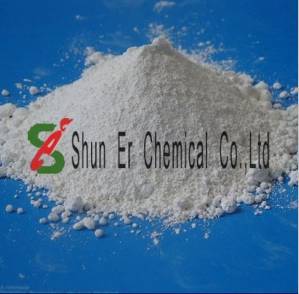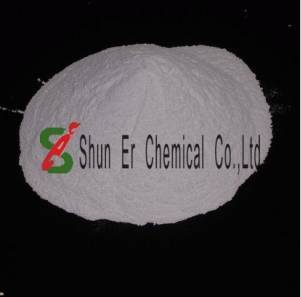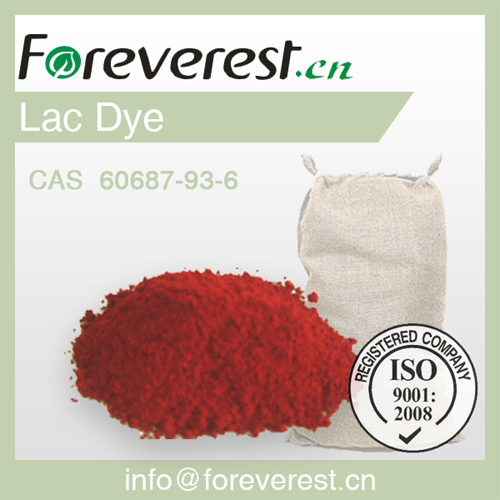Lac Dye Cas 60687 93 6 Foreverest - China
price: contact company for price
Lac dye is a yellowish red powder.
Dissolved in water it
turns bluish, dark red.
Lac dye is soluble in ethyl alcohol
and methyl alcohol, also in acetone and acetic acid.
Lac dye
is partially soluble in water and ether.
Lac dye is very
lightfast and resistant to temperature, it melts at 180° C
and decomposes at approx.
230° C.
Lac dye may be used for dying of textiles, such as silk,
cotton, wool.
It may also be used for oil painting, in
shellac varnishes and possibly in watercolours.
Lac dye is obtained from the females and eggs of the insects
known as Coccus lacca, which infest various trees,
especially fig trees, indigenous to Asia and China.
They,
and kermes and cochineal insects, are of a type commonly
called "shield-louse", as they are small and round with a
shield on the back.
Female lac insects have vestigial wings
and legs and spend their whole life gathered in large
clusters on host plants.
When lac dye is harvested, its
animal origin is virtually unrecognisable, because it is a
solid substance made up of bodies of female insects which
are dead, each with some 200 to 500 unhatched eggs, all
surrounded by a brown-red, hardened exudation.
Individual
insects are not visible, and the whole substance looks like
some form of growth on the host plant.
It is collected by
breaking off lac-bearing branches before the larvae hatch.
Some lac is left, and at swarming time the larvae of minute
size can be seen for a few days moving about to find a place
on the tree to settle and feed.
In ancient times Asiatics, who were able to observe the life
cycle, knew that lac was a substance of animal origin, so
various names meaning "little worm" were developed for lacca
and similar insects.
To Europeans, however, lac appeared to
be part of the sticks on which it was imported, thus the
name coccus (berry or acorn) was attached to lac and later
to the live insects, a misnomer for which the ancient Greeks
and Romans are held responsible.
Discussion on the confused nomenclature connected with a
number of red pigments has been undertaken by other writers.
The origin of the links between Latin coccus and granum and
English grain (all of which are associated with the idea
that lac was a seed or berry), and the links between kermes
and vermiculum (both meaning little worm) are to be found
during the medieval period and they are ably discussed by
Thompson.
When continuing the discussion with special
reference to seventeenth-century England, it is possible to
ignore the name grain, which, apart from its specialised use
in textile dyeing, was obsolete.
Nevertheless, the
seventeenth century presents an additional problem in that
the words cinnabar and sinopiawere wrongly associated with
the name sinoper lake, which may have been a development of
the medieval name cynople (Latin sinopia) mentioned by
Thompson.
Sinoper lake and the variation topias are to be found in
sources dating from the late sixteenth and early seventeenth
centuries.
The composition of both is uncertain; Thompson
states that medieval cynople was a composite lake, and it
seems that sinoper may have been similar, for that mentioned
in B.M. MS.
Sloane 1394 was derived from the dye in scarlet
cloth.
Company Contact:
- Posted By: Foreverest Resources Ltd.
- Phone: 865925105533
- Address: Flat 1604, No. 36, Lianbinli, Siming Dist, Xiamen,, Xiamen , China
- Email:

- Website: https://foreverest.net
Published date: August 30, 2013
- Business Description: FOREVEREST is the leading supplier of pine chemicals, such as gum rosin & derivative, gum turpentine & derivative products and other pine chemicals.
Manufacturing by renewable and environmentally friendly raw materials since 1988.
Foreverest Resources Ltd. is a family-owned company, which specializes in pine chemicals and provides reliable and comprehensive solutions for pre-sale & after-sale services.
With 30 years of history in R&D of forest chemicals products in China, we focus on supplying the substitutes of natural products.
Our products include modified resins, terpene based derivatives, flavor & fragrance ingredients, and other biobased chemicals to meet the unique demands of Detergents & Disinfectants, Flavors & Fragrances, Adhesives & Printing Inks, Pharmaceutical & Personal Care, Food & Beverages, and Agrichemical & Cleaning industry, etc.
Related listings
-
 Pigment Grade Comestic Ceramic Metallurgical Chrome Oxide Green RefractoryChemicals - Dyes / Pigments - Gansu Jinshi Chemical Co.,Ltd - China - August 13, 2013 - contact company for price
Pigment Grade Comestic Ceramic Metallurgical Chrome Oxide Green RefractoryChemicals - Dyes / Pigments - Gansu Jinshi Chemical Co.,Ltd - China - August 13, 2013 - contact company for priceChrome Oxide Green---Pigment grade/Comestic grade/Ceramic grade/Meta llurgical grade Chrome Oxide Green refractory grade 1.Properties: C lassification: Pigment, abrasive, low sexivalent chrome, metallurgical and refactory grade CAS No.: 1308-38-9 Oth...
-
 Lithopone B301 C I Pigment White 5 77115Chemicals - Dyes / Pigments - HeBei Shun Er Chemical Co.,LTD. - China - June 14, 2013 - contact company for price
Lithopone B301 C I Pigment White 5 77115Chemicals - Dyes / Pigments - HeBei Shun Er Chemical Co.,LTD. - China - June 14, 2013 - contact company for priceLithopone is non-toxic white powder, insoluble in water, applied to all plastic, paint, coatings, thermoplastics, thermosets and paper. Product Name:Lithopone Synonyms: C.I. Pigment White 5; C.I. 77115; Pigment White 5; Molecular Formula:Zn2BaS2O5 Mo...
-
 Lithoponeb311 Barium Zinc Sulfate SulfideChemicals - Dyes / Pigments - HeBei Shun Er Chemical Co.,LTD. - China - June 14, 2013 - contact company for price
Lithoponeb311 Barium Zinc Sulfate SulfideChemicals - Dyes / Pigments - HeBei Shun Er Chemical Co.,LTD. - China - June 14, 2013 - contact company for priceLithopone is a mixture of zinc sulfide and barium sulfate. It is called inorganic white pigment. It widely used as white pigment of plastics such as polyolefin, vinyl resin, ABS resin, polystyrene, polycarbonate, nylon and paint. Product Name:Lithopo...
Safe Trade Tips
- Ask for business references and check them
- Use a payment method that offers better protection for all such as Letters of credit and verified professional escrow services. Avoid payments in advance such as money transfers
- Verify their business via their local Chamber of Commerce
- Search the internet using their website address, their business name, their phone and fax numbers, and their email addresses to see if you can find any feedback about them.
- Get to know more about scams and fraud to avoid: Internet Crime Complaint Center - Consumer Financial Protection Bureau
- This site is never involved in any transaction, and does not handle payments, shipping, guarantee transactions, provide escrow services, or offer "buyer protection" or "seller certification"
